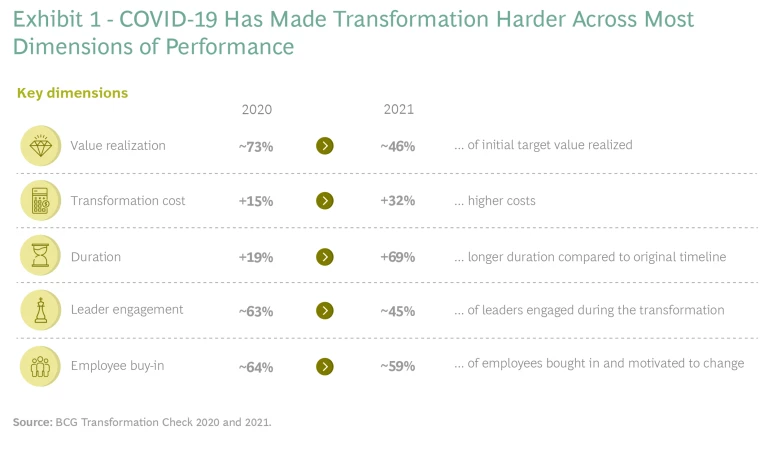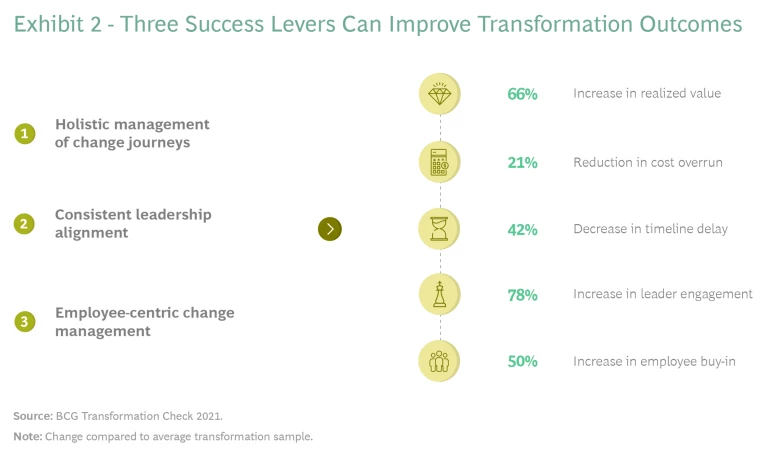Large-scale transformation is hard even under ideal circumstances, but in the current business environment—with an ongoing pandemic, supply chain issues, macroeconomic uncertainty, and other complicating factors—the margin of error has gotten even smaller. Now, data is available to quantify the challenge. The latest version of an annual survey commissioned by BCG has found that transformations take longer than they did a year ago, while also yielding less value and achieving lower engagement levels among leaders and employees. More than half (57%) of all transformations fail to hit their targets in terms of value envisioned, timeline, or both—up from 40% a year ago. Thankfully, that same survey data reveals key success factors that companies can use to overcome these issues.
This is the third survey that BCG has conducted into transformation efforts worldwide, following similar studies done in late 2019 and late 2020 . All three have shared a common goal: to give company leaders an objective, data-driven understanding of the current environment for transformation and how they can successfully design and implement change programs.
BCG has developed a clear set of principles for companies to follow in order to increase their odds of transformation success, and those core principles are just as relevant as ever. (See “Three Transformation Journeys.”) In this environment, however, only the best companies can execute transformations well. The good news is that those companies offer clear lessons that can help other organizations’ chief transformation officers (CTOs), CEOs, and other leaders identify where and how to focus their attention and resources—and boost their odds of success.
Three Transformation Journeys
Leader Journey. At the beginning of a change program, a small team of senior leaders comes together to define the ambition and vision and to articulate the case for change. Those insights then cascade first to the broader leadership team and ultimately to frontline leaders, to activate them and to drive behavioral change.
People Journey. The second journey underpinning transformation relates to employees. A successful transformation requires clear communication so that employees understand the underlying rationale (the “why”), the specific changes that need to happen (the “what”), and the measures that must be in place to bring employees along (the “how”). Those communications should be two-way, with leaders soliciting input from employees, rather than simply issuing orders from above. And, critically, employees need to understand how their daily work will change—what new skills they will need to master, which specific activities they should focus on or drop, and how leaders will evaluate their performance.
Program Journey. Finally, the overall transformation requires strong oversight and governance, through a transformation management office run by a senior leader and staffed by teams whose sole task is to oversee the transformation (rather than having to handle it on top of their other responsibilities). Through this kind of structured governance, companies can generate visibility into the transformation’s current status, reallocate resources as needed, and ensure that the transformation proceeds on time and on budget.
The Margin of Error Gets Smaller
The latest version of BCG’s transformation survey drew responses from approximately 1,000 companies representing a wide range of industries. One key theme of the findings is that average transformation performance has worsened in all dimensions compared to the 2020 survey results. (See Exhibit 1.) Fewer than half of all transformations now realize their target value. Costs have nearly doubled, and the average delay in timelines has tripled. Both engagement among company leaders and buy-in among employees have declined significantly.

In addition, the overall distribution of performance shows a wider spread between leaders and laggards. For example, the number of companies with a transformation success rate of 90% or better (as self-assessed by respondents) has declined by half compared to the numbers in our 2020 study.
It’s not hard to figure out why. Transformation requires large shifts in technology, business models , ways of working, and other elements that are central to a company’s DNA. Those changes were difficult enough to implement before COVID-19, but the pandemic has dramatically compounded the challenge. Management teams are understandably distracted by the challenge of keeping operations and businesses running while also ensuring the safety of employees and customers. In addition, work-from-home and hybrid models make it harder for leaders to engage and mobilize organizations.
Unfortunately, those challenges aren’t going away. As the pandemic drags on, it’s increasingly apparent that the business environment will not quickly pivot back to normal. Instead, the world is likely to continue to slog through the pandemic, with ongoing unexpected ramifications and challenges. As a result, it’s more important than ever for companies to learn from others that have managed their transformation most successfully.
The Three Elements That Characterize Transformation Leaders
What do these leading companies do differently? In our analysis, three key elements closely correlate with better performance: holistic management of change journeys, consistent leadership alignment, and employee-centric change management . Among the companies in our sample, the transformation leaders use these three levers to improve their performance on multiple metrics—including greater realized value, lower transformation costs, shorter project timelines, and increased engagement and buy-in from leaders and employees. (See Exhibit 2.)

Notably, our 2020 analysis highlighted these same success levers, but their positive effects are compounding in the current business environment. For example, the increase in realized value jumped from 32% in 2020 to 66% in 2021. The reduction in cost overruns grew from 10% in 2020 to 21% in 2021. The same playbook applies, but it is leading to bigger differences in performance.
Holistic Management of Change Journeys. Successful transformation leaders don’t just define a clear case for change for the transformation and explicitly emphasize how the effort will unlock value for shareholders and other stakeholders; they also embed it effectively in the organization. How? They set up transformation teams composed of groups of 10 to 15 people that are responsible for pursuing a manageable number of initiatives over a reasonable timeline; on average, programs include 10 to 20 initiatives and last one to three years. These teams function through a transformation management office (TMO), led by an executive who reports directly to the CEO or CTO. Leaders also use agile governance structures such as impact centers—physical spaces supported with meeting routines and rhythms that create transparency for leaders, encourage collaboration within and among teams, and maintain a laser focus on value.
Change Your Trajectory: Monthly insights on business transformation.
The survey data yielded two crucial insights on this topic:
- 90% of transformation leaders articulate a clear case for change, compared with just 74% of companies with failed transformations. Transformation leaders energize and engage the organization by effectively defining and cascading its purpose and its case for change. This entails developing leader action plans (to support leaders in translating the case for change into actionable behaviors and embedding it in their daily routines) and formulating a dedicated communication on the case for change (to deliver that case across the entire organization). Both measures are critical to ensure successful long-term embedding of the case for change in the organization.
- 77% of transformation leaders establish clear value drivers, compared with just 52% of less successful companies. Transformation leaders identify, foster, and reinforce value-creating behaviors and set the right organizational context for them.
Consistent Leadership Alignment. The second major factor that differentiates transformation leaders is having a leadership team that aligns on a common goal and works together to implement the program. The senior team, including the C-suite and the board, must articulate the case for change—clarifying what needs to change and why in a way that sets the tone for the rest of the organization. They must use different communication channels, particularly digital ones, given the sprawling nature of large organizations and the fact that a significant portion of the workforce now works remotely. Using digital channels also enables companies to personalize key aspects of their communication, crafting messages that resonate with individuals, rather than issuing a single blanket statement. The survey data revealed two key findings on this point:
- 49% of transformation leaders had complete alignment of the leadership team and consistent communication throughout the effort, compared with just 26% of transformation failures. Transformation leaders align the leadership team on the scope and objectives of the transformation and help employees understand why they need to be active participants in the change.
- 60% of leaders have a communication roadmap in place, compared with just 40% of transformation failures. Top performers define a comprehensive communication and mobilization strategy that includes feedback mechanisms so that they can revise and adjust the communication plan as needed. Ideally, a senior executive is responsible for developing the overarching communications approach, with the communications department and the TMO leader taking supporting roles.
Employee-centric Change Management. The third element is a focus that places employees at the epicenter of change. Transformation leaders don’t just hand down a finished plan for employees to carry out; they explicitly engage employees in developing the plan. This approach empowers employees to contribute to identifying problems and designing solutions at a granular level, which leads to the formulation of measures that are grounded in real-world experience and, therefore, more likely to succeed.
Transformation leaders don’t just hand down a finished plan for employees to carry out; they explicitly engage employees in developing the plan.
In our survey, 46% of transformation leaders explicitly focus on employees as the epicenter of change, compared with 29% of laggards. This approach builds a sense of ownership and engagement. Employees are more likely to embrace the change because it’s theirs—they were entrusted with the task of helping craft it. As one company leader put it, “Try to create a culture where people really want to make things better, and adopt a mindset focused on innovation and entrepreneurship.”
The margin of error for transformation may have shrunk as a result of COVID-19, but companies still face an imperative to transform. They cannot cling to the status quo or wait for conditions to become more favorable. In that light, the survey data from transformation leaders is like a lighthouse in a storm. By using these insights, companies can understand the pitfalls of transformation now and focus their resources and energy in the right areas to improve their odds of success. In doing so, they will set themselves up to compete more effectively and create more value.
Kristy Ellmer, Christin Owings, Dave Sivaprasad, David Kirchhoff, and Christoph Hilberath also contributed to this publication.









